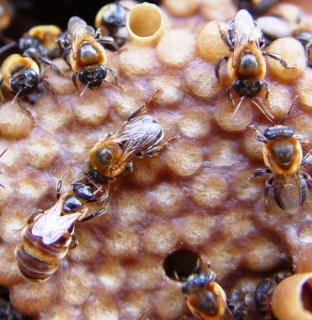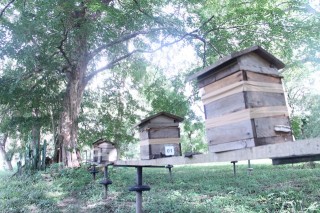
The challenge of preserving species from “native bees”
26/04/2014
Outdoors, in small wood reforestation boxes with 39 cm height 24 cm wide, with scientific rigor in the management and look into the future, preserve up jewels of Brazilian fauna threatened with extinction. It is a germplasm bank of stingless bee species native to the Northeast, with live colonies kept in standard hives.
 Created six years ago, at Embrapa Mid-North, in Teresina (PI), the bank is characterized by bringing together colonies of tiúba bee species, uruçu yellow and Jandaira, also known as native bees, to be created before the Portuguese arrived in Brazil. It is the only species in the region and was assembled from beekeepers donations. In contrast, the technical team offers training to producers.
Created six years ago, at Embrapa Mid-North, in Teresina (PI), the bank is characterized by bringing together colonies of tiúba bee species, uruçu yellow and Jandaira, also known as native bees, to be created before the Portuguese arrived in Brazil. It is the only species in the region and was assembled from beekeepers donations. In contrast, the technical team offers training to producers.
"This bank is a strategic weapon of science to repopulate the fauna of the Brazilian Northeast, in the eventual extinction of local native species ", highlights the Fabia Pereira researcher. If necessary, restocking will be made from the distribution of hives to beekeepers in the affected regions. The first function is to help in preserving, but the main objective includes conservation and documentation of genetic resources available for the target audience.
Research invest in nest architecture and analysis of honey, the search for biological information on each species and morphological characterization, molecular and geographic bee. Besides, They have also proposed as information on good quality honey production, multiplication of colonies, maintenance of native bees and flora associated with them, as well as environmental preservation and income generation for smallholders.
 Demonstration units are held in the municipalities of Guadalupe and Uruçuí, in southeastern Piauí, and Araioses and São João dos Patos, in eastern Maranhão. There is, also, genebanks in Pará and Pernambuco. Samples are sent to the Tissue Bank, installed at Embrapa Genetic Resources and Biotechnology, in Brasilia (DF), for preserving DNA. Embrapa is the target install genebanks of bees throughout the country.
Demonstration units are held in the municipalities of Guadalupe and Uruçuí, in southeastern Piauí, and Araioses and São João dos Patos, in eastern Maranhão. There is, also, genebanks in Pará and Pernambuco. Samples are sent to the Tissue Bank, installed at Embrapa Genetic Resources and Biotechnology, in Brasilia (DF), for preserving DNA. Embrapa is the target install genebanks of bees throughout the country.
The importance for pollination
Stingless bees, according to Fábia Pereira researcher, They are responsible for pollination 30 a 60 percent of plant ecosystems such as the Caatinga, the Pantanal and patches of Atlantic Forest. "They perform an important role in perpetuating the forest and itsbiodiversity, as pollinators and part of the food web ", highlights.
More than 400 stingless bee species are known in Brazil. They have great heterogeneity in color, size, form, nesting habits and population nests. Fábia Pereira explains that some bees adapt to management, other non-: "Although advantageous, the rational creation of these bees is hampered by the lack of biological information and husbandry. Many have not even been identified ".
The price of honey liter of native bees may reach R $ 70,00. This high price, coupled with low initial investment and ease in keeping these bees next to homes, It has encouraged small farmers to enter the activity.
Climate and flora are favorable to production
China is the world's largest honey producer. The Americans are in second and Argentina third. Brazil is the ninth largest honey producer and fifth largest exporter. The United States are the largest buyers of Brazilian honey.
The Northeast region has favorable environment to expand honey production. The native and diverse flora is a great asset. Paulo José da Silva, from 33 years, Manager of Mixed Beekeepers Cooperative of the Microregion Simplicio Mendes (PI), highlights the variation in flowering north of the southern state, all or anus, as a balance in activity: "With this environment, the beekeeper is able to migrate hives with lower cost ", evaluates Paulo José da Silva, Manager of Mixed Beekeepers Cooperative of the Microregion Simplicio Mendes, Piauí.
The Apis House is one of the largest plants in the Northeast Beekeepers unions, based in Picos, Piauí. The Director General, Leopoldino Antonio Dantas Son, believes that there is an abundant flora throughout the region. "We need to qualify the producer to overcome poverty in semi-arid". I do not state, sustainability is an important factor. The researcher Maria Teresa Rego says that the flowering of native species "are pesticide-free, providing a pure honey, free from chemical residues, which favors the production of organic honey ".
The effort to keep the Northeast at the forefront of the major honey producers in Brazil is anchored by a major initiative for the entire production chain: the quality control laboratory of apiculture products, Embrapa, in Teresina. In him, are made honey analyzes for information as to maturity, purity and degradation. They indicate, for example, moisture content, percentage of reducing sugars and hydroxymethylfurfural content, which is a compound formed by heating or aging of honey. The lab also makes propolis and pollen analysis beekeeping. All the honey exported from Piauí by cooperatives plants undergoes analysis at Embrapa Mid-North.
Drought and pesticide, exterminators agents
The drought and pesticide exterminators are strong agents of bees. The drought, in the Brazilian Northeast is cyclical, kills bees gradually. First, reduces the extreme food supply. Then, stressed animals. Finally, forest and reduces frightening figures swarms.
The result of the dry and cultured on the native flora is disastrous. "They lose important species, as bees are responsible for pollinating - reproduction of plants. With that, abundant fruits and seeds, fundamental for human and animal ", explains the researcher Maria Teresa Rego.
Another aspect to be considered is that climate change has driven the proliferation of pests, como a Helicoverpa armigera, Attacking important cultures, as soy, corn and beans. To face the attack of pests, many farmers use pesticides indiscriminately and, this practice effects that come exterminate the bees. The lethal kills the insects immediately. The sublethal have slower effect. Contaminated, Bee back to the hive with the poison and then passes on to the other. The ending is predictable: the whole hive is poisoned and, consequently, bees die.
Often, they do not kill the colonies directly, but cause effects on behavior, hampering development, production and pollination service the colonies. One of the effects related to the use of pesticides is currently very researched the Colony Collapse Disorder (DCC). According to researchers, it is characterized by the absence of live or dead bees in the colony. Early stage, no presence of a small amount of workers, new brood and queen.
The researcher Maria Teresa Rego says that the causes of the disorder are still being investigated. Until now scientists believe in a chain reaction, affecting the immune system of bees, caused by viruses, Mites, stress, malnutrition and pesticides.
The producer has to be careful to identify whether the colonies are being affected by the application of toxic substances. According to the scientist, It is important to note: amount of dead bees near the colonies, reducing the amount of adult workers, and reduced pup mortality in propitious time for the development of the colonies and the reduction of food-gathering activity and malformation of larvae and adult workers.
To avoid the impact of pesticides, Maria Teresa Rego recommends integrated pest management, with emphasis on biological control. In the case of dry, the research investigates appropriate managements. The studies advance to simple and efficient recommendations as providing easily accessible food, the example of seasonal fruit juices and cassava leaf flour. To ease the heat, researchers study hives in shady locations course - under trees - or under artificial coverings, built by the beekeeper. IS, to escape from natural enemies, like ants and termites, the recommendation is to install hives on easels, in addition to maintaining the apiary area clean.
Source: Embrapa
http://sna.agr.br/o-desafio-de-preservar-as-abelhas-indigenas/

Sorry, the comment form is closed at this time.